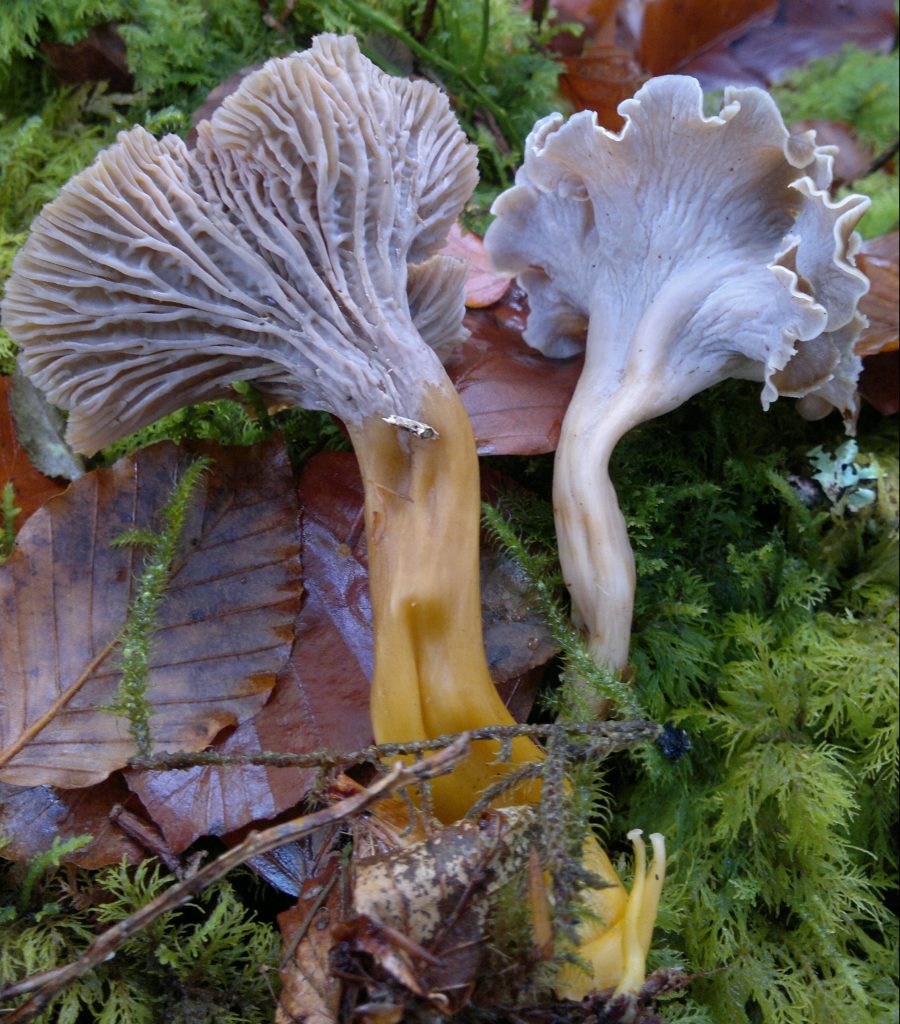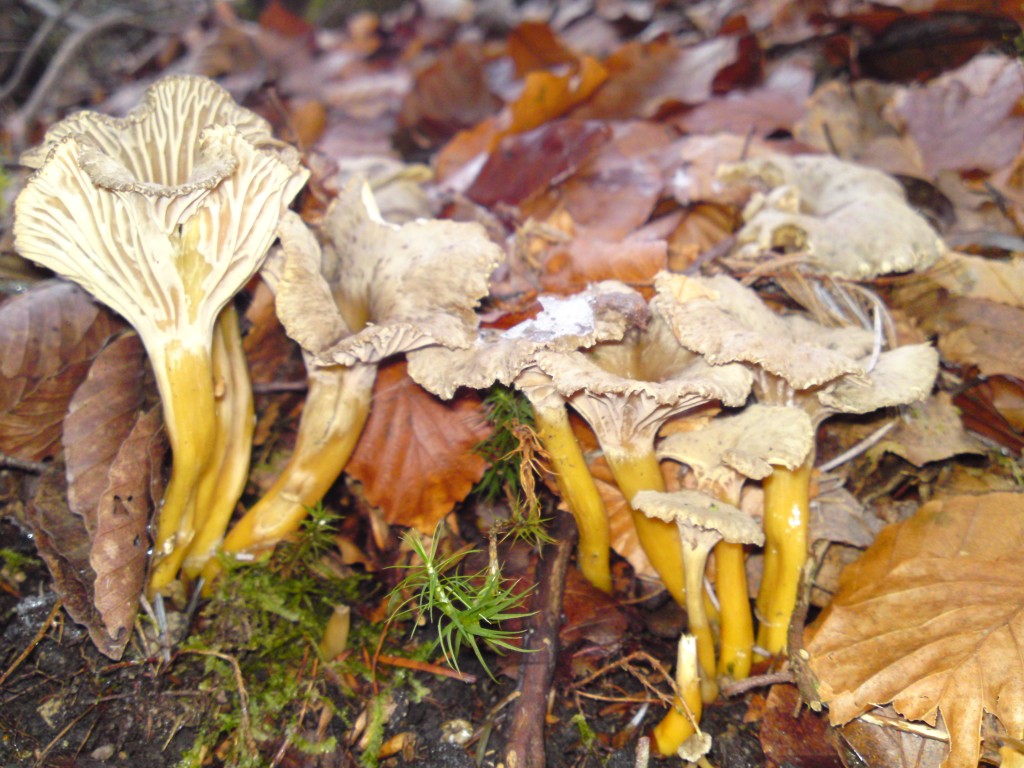Winter Chanterelle – Edibility, identification, distribution.
Craterellus tubaeformis, AKA Yellowlegs
- Edibility: 4/5 – Great earthy flavour that belies their flimsy appearance
- Identification: 4/5 – see descriptions of several species that often get called winter chanterelles below
- Distribution: 3/5 – Reasonably common and often occurring in large numbers where established
- Season: September – January (stopping growing after first heavy frost, but fruit bodies often persisting for some time after that
- Habitat: Spruce, pine, beech, with a preference for heavy leaf/needle cover and particularly moist slopes
Several similar species to craterellus tubaeformis are often lumped together as “winter chanterelles”:
Golden chanterelle (craterellus aurora) shares the same id and edibility scores but rarer (2/5). Distinguished by wrinkled surface on the underside of the cap rather than pseudo-gills of c.tubaeformis.
Ashen chanterelle (craterellus cinereus) is very similar, lacking the yellow colouration – also edible.
Sinuous chanterelle (Pseudocraterellus undulatus) is also similar, though lacking gills and yellow colouration – also edible.

L Golden chanterelle (craterellus tubaeformis) v R Sinuous chanterelle (pseudocraterellus undulatus)
The winter chanterelle is a common, easy to identify and delicious mushroom that can be picked in large numbers right through November and well into December in most of the UK.
With their drab brown caps (3-7cm across) and flimsy flesh, winter chanterelles aren’t nearly so glamorous as the true yolky-golden chanterelle (Cantharellus Cibarius). Confusingly, the French refer to our chanterelles as girolle and winter chanterelles as chanterelles. Thats why you will often find up-market (or possibly pretentious) restaurants selling girolle. As if the world of wild mushrooms wasn’t confusing enough! This is why scientific names are really useful sometimes – although even they change quite regularly as scientists re-categorise (not so long ago, C. Tubaeformis was known as Cantherellus Infundibuliformis).
Fortunately, once you look beneath the wavy, irregular cap, identification becomes much easier.
Most obvious is the bright yellow/orange stem which gives the common name of yellow-leg. The beige gills are also distinctive by being vein-like rather than deeply grooved (think combed plastercene) on trumpet chanterelles, or even less substantial wrinkles in the case of golden chanterelles. These two species are so similar to the non-scientist that in this instance it isn’t crucial to distinguish between them – both are good eating mushrooms with a sweet fruity scent (you need to stick your nose in a basketful to smell this) and a delicate, earthy flavour. A final identification feature is the funnel-like cap and hollow stem of fully grown specimens.
Spotting the dingy caps of winter chanterelles in leaf-strewn woodland can be incredibly difficult – even if you know where you are looking. I return every year to a specific tree beneath which I know they will be growing, but it can still take several minutes to spot the first one. Then, as so often occurs while foraging, my eyes seem to tune into the right wavelength and dozens of mushrooms magically emerge from the leaf litter.
Where established, they can occur in large numbers – I once found a densely packed foot wide pathway of them forming a huge ring. In the exact centre of the ring was a large and perfectly formed penny bun. No wonder mushrooms are often associated with fairies!
Winter chanterelles mostly grow in association with conifers, especially beneath spruce and pine, though I find plenty under beech and western hemlock trees too. You can even find them in those large, soulless deserts of sitka that support very little else (mushrooms don’t need light to thrive), though in my experience they prefer habitats with a good damp covering of moss and leaf or needle litter.
Though perhaps not quite in the first tier of gourmet fungi, winter chanterelles easily top the second tier, and can vastly improve any mushroom dish. They have a high water content so I sometimes resort to wringing them out before cooking. Roast/fry them quite hard once you have driven off most of the moisture. Their slippery texture and earthy flavour make them a natural partner in creamy, garlicy sauces – especially with linguine. They grow during the pheasant shooting season and fit naturally in any game casseroles, pies or stews
Recipe: Pheasants with winter chanterelles and root vegetables
If you are lucky enough to find some, the chances are you will gather enough for more than one meal. I recommend preserving gluts by lightly simmering in a 3:2:1 in vinegar solution (3 parts water, 2 parts cider vinegar, 1 part sugar) then preserving in oil, or sauté in butter then freeze. They also dry quite quickly and well in a dehydrator, warm, airy space, or in a very low fan oven with the door left slightly open.
Related Posts:
- Edible wild fungi guide
- In Season Now
- An Introduction to Fungi Foraging
- Winter Foraging
- Learn To Forage





7 Comments
Nice article but I totally disagree with the fact that they don’t dry well .I dry 100’s of litres a year and they take far less room than sauteed ones .If you mail me will give you recipe for winter chantrelles that will force you to give it 5/5 for taste .I have just had for breakfast ,rye bread topped with melted cheddar cheese ,sauteed winter chantrelles ,a slice of crispy fried bacon and a few thyme leaves . We also find them under birch and poplar trees .
I have just found a fabulous patch in the french alps – a steep ravine with moss. However, as I am new to mushroom foraging, can you tell me if I can pick from the same patch again and again in a season, and how long should I leave between pickings? Thank you.
Winter chanterelle mycelia can be vast, with different parts “fruiting” at different times, so it is worth revisiting the spot. If carefully harvested, with minimal trampling, it will fruit for many years.
Do you have notes on foraging mushrooms in the LI, NY area?
No sorry.
Mark, so chanterelles are terrible when dried, BUT you’re saying that Winter Chanterelles can be dried and it does not adversely effect the taste?
Pretty much…though I wouldn’t say chanterelles were terrible dried – just a shadow of their former glory! Winter chants dry and reconstitute most excellently